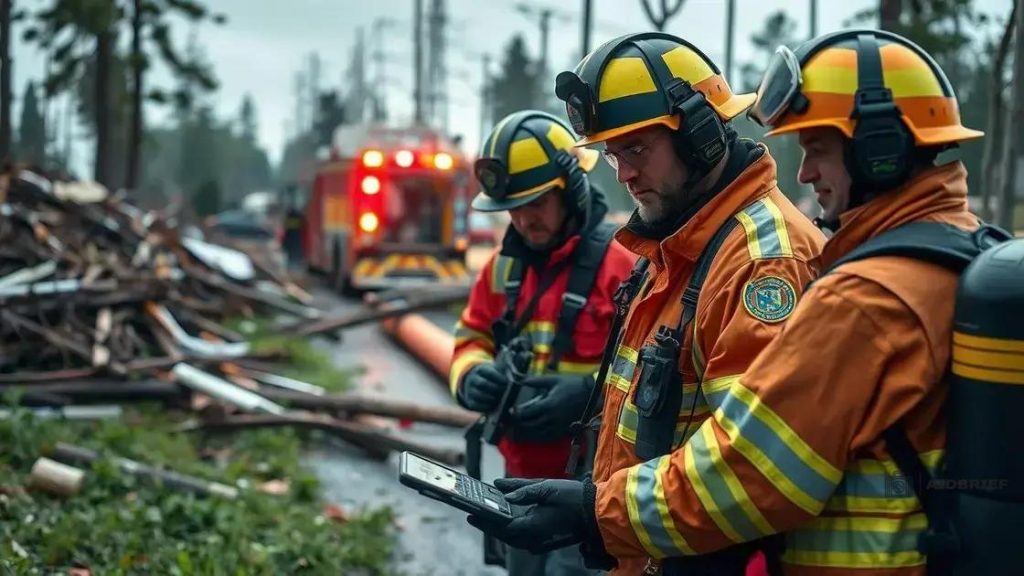AI in natural disaster response: innovative management techniques

AI in natural disaster response improves emergency management by utilizing predictive modeling, real-time monitoring, and effective communication, enabling faster decisions and better resource allocation during emergencies.
When it comes to managing crises, AI in natural disaster response is proving to be a game-changer. Imagine a world where technology helps save lives during emergencies. This article delves into how AI is reshaping emergency management and the exciting possibilities it holds.
Understanding AI in disaster scenarios
Understanding AI in disaster scenarios is crucial for improving emergency response. By leveraging technology, organizations can enhance their ability to act swiftly during crises.
Artificial Intelligence helps in processing vast amounts of data quickly, which is vital during natural disasters. AI applications analyze weather patterns and predict potential disasters, allowing teams to prepare effectively.
Key Components of AI in Disaster Management
The integration of AI involves various elements that work together to inform and guide responders.
- Real-time data collection: Sensors and drones gather information from the disaster area.
- Predictive analytics: AI models forecast disaster impacts using historical data.
- Resource allocation: AI optimizes the deployment of personnel and equipment, ensuring efficiency.
Moreover, AI’s ability to learn from each disaster aids continuous improvement. For instance, after a major event, AI systems can analyze what worked and what didn’t, refining future responses.
Partnerships between AI developers and disaster response teams enhance the development of tailored solutions. These collaborations help create tools that can handle unique challenges faced in each situation. AI in disaster scenarios drives innovation by bridging gaps and improving the overall safety and speed of emergency responses.
The role of data analytics in emergency response
The role of data analytics in emergency response is vital for ensuring effective and timely assistance during crises. It allows teams to make informed decisions based on real-time information and historical data.
Using data analytics, emergency responders can quickly assess situations, prioritize needs, and allocate resources efficiently. This process often involves analyzing patterns from previous disasters to anticipate future challenges.
Benefits of Data Analytics
- Improved decision-making: Access to accurate data helps teams respond more effectively.
- Resource optimization: Data reveals where resources are needed most, reducing waste.
- Risk assessment: Predictive analytics identifies potential hotspots for disasters.
Additionally, data visualization tools can present complex information in a digestible format, allowing responders to grasp situations at a glance. For example, maps showing affected areas help teams identify which locations need immediate attention.
Furthermore, integrating social media data into analytics provides insights into public sentiment and urgent needs. This allows emergency services to tailor their responses to community demands, ensuring that the most pressing issues are addressed swiftly. By harnessing the power of data analytics, responders not only save time but also increase the effectiveness of their operations during emergencies.
Real-time monitoring and communication improvements

Real-time monitoring and communication improvements are essential for effective emergency management during disasters. These technologies allow responders to act quickly and coordinate efforts more efficiently.
With real-time monitoring systems, emergency teams can track developments as they happen. For instance, GPS-enabled devices help in locating affected areas and assessing damage quickly. This immediate access to information is crucial for making informed decisions.
Technological Advances
Innovative tools in monitoring and communication have transformed how teams respond to disasters.
- Real-time alerts: Automated systems send notifications to rescue teams as situations evolve.
- Mobile communication platforms: Apps enable seamless chats between responders in the field.
- IoT devices: These collect data from the environment, providing valuable insights into conditions on the ground.
Moreover, using drones for aerial surveillance gives responders a bird’s-eye view of disaster zones. This capability helps identify hazards that may not be visible from the ground. Drones can also deliver supplies to hard-to-reach areas, bridging the gap during critical moments.
In addition, establishing a strong communication network enhances collaboration among different agencies. By sharing information in real time, responders can optimize their actions and save more lives. Overall, the role of real-time monitoring is vital in ensuring a swift and effective disaster response.
AI-driven predictive modeling for disasters
AI-driven predictive modeling for disasters plays a significant role in enhancing readiness and response efforts. By analyzing vast amounts of data, AI can forecast the likelihood and impact of disasters, allowing communities to prepare better.
Using historical data, machine learning algorithms identify patterns that indicate potential disasters. This analysis can range from predicting hurricanes to assessing earthquake impacts. The modeling not only helps in predicting when and where disasters may occur but also in understanding their possible severity.
Benefits of Predictive Modeling
Integrating AI into predictive modeling provides various advantages for emergency management.
- Early warning systems: These systems alert communities before disasters strike, giving them time to evacuate or take necessary precautions.
- Resource allocation: Predictive models help determine the best ways to distribute resources before and after an event.
- Improved planning: Organizations can develop strategies based on potential disaster scenarios, enhancing overall readiness.
Moreover, AI models continually learn and adapt. As new data becomes available, these models improve their accuracy and reliability. For instance, if a specific region frequently experiences flash floods, AI can refine its predictions to account for changing environmental conditions.
In addition, different sectors, from health to transportation, benefit from these predictive capabilities. Hospitals can stock supplies and plan for influxes, while transportation agencies can optimize routes for emergency vehicles. Overall, AI-driven predictive modeling empowers communities to face disasters with more information and readiness than ever before.
Case studies: Successful AI applications in past emergencies
Case studies: Successful AI applications in past emergencies demonstrate how technology can significantly enhance disaster response and management. These real-world examples showcase the practical benefits of integrating AI into emergency operations.
One notable instance is the use of AI in predicting and managing wildfires. During the 2020 California wildfires, machine learning algorithms analyzed data from previous fires to forecast potential fire spread. This timely information allowed evacuation orders to be issued promptly, ultimately saving lives.
Examples of AI in Action
Several other scenarios highlight the effectiveness of AI applications in emergencies.
- Hurricane forecasting: AI systems analyzing weather patterns have improved the accuracy of hurricane predictions, helping communities prepare ahead of time.
- Disaster recovery efforts: In Japan, AI was employed to assess earthquake damage quickly. Drones equipped with AI technology surveyed affected areas, providing detailed maps for recovery teams.
- Public health responses: During the COVID-19 pandemic, AI assisted in tracking virus outbreaks. Predictive models helped health officials allocate resources where they were needed most.
Moreover, the usage of AI during the 2018 Japan floods is another example worth noting. AI-powered tools analyzed satellite data and real-time information to guide rescue operations. This approach improved coordination between agencies and ensured that help reached those in need quickly.
By learning from past emergencies, AI continues to enhance future disaster response plans. The insights gained from these case studies highlight how AI can transform emergency management into a more effective and proactive effort.
In summary, the integration of AI in natural disaster response is revolutionizing emergency management. From predictive modeling to real-time monitoring, AI offers tools that enhance the ability to prepare, respond, and recover from disasters. Successful case studies from past crises illustrate the potential of AI to save lives and optimize resource allocation. As technology continues to evolve, the future of emergency management looks promising, making communities safer and more resilient.
FAQ – Frequently Asked Questions about AI in Natural Disaster Response
How can AI enhance emergency management during disasters?
AI enhances emergency management by providing predictive modeling, real-time data analysis, and improved communication, enabling quicker and more efficient responses.
What role does predictive modeling play in disaster response?
Predictive modeling helps anticipate disasters by analyzing historical data and forecasting potential impacts, allowing teams to prepare and allocate resources effectively.
Can AI improve communication among emergency responders?
Yes, AI improves communication through real-time monitoring systems and mobile platforms, ensuring that responders can exchange information quickly and coordinate efforts more effectively.
What are some successful case studies of AI in disaster situations?
Examples include AI applications in wildfire prediction, hurricane forecasting, and earthquake damage assessment, all showcasing AI’s ability to save lives and optimize resource allocation.





